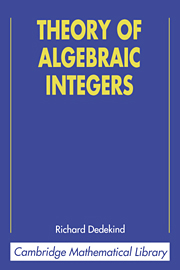2 - Germ of the theory of ideals
Published online by Cambridge University Press: 06 January 2010
Summary
In this chapter I propose, as indicated in the Introduction, to explain in a particular case the nature of the phenomenon that led Kummer to the creation of ideal numbers, and I shall use the same example to explain the concept of ideal introduced by myself, and that of the multiplication of ideals.
The rational integers
The theory of numbers is at first concerned exclusively with the system of rational integers 0, ±1,±2, ± 3, …, and it will be worthwhile to recall in a few words the important laws that govern this domain. Above all, it should be recalled that these numbers are closed under addition, subtraction and multiplication, that is, the sum, difference and product of any two members in this domain also belong to the domain. The theory of divisibility considers the combination of numbers under multiplication. The number a is said to be divisible by the number b when a = bc, where c is also a rational integer. The number 0 is divisible by any number; the two units ±1 divide all numbers, and they are the only numbers that enjoy this property. If a is divisible by b, then ±a will also be divisible by ±b, and consequently we can restrict ourselves to the consideration of positive numbers. Each positive number, different from unity, is either a prime number, that is, a number divisible only by itself and unity, or else a composite number. In the latter case we can always express it as a product of prime numbers and – which is the most important thing – in only one way.
- Type
- Chapter
- Information
- Theory of Algebraic Integers , pp. 83 - 102Publisher: Cambridge University PressPrint publication year: 1996



